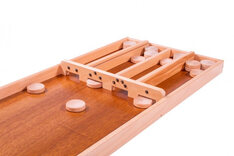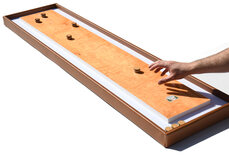The Rules of Crokinole
Crokinole is a disk flicking game that was probably invented in Canada before 1870. The rules here are based on the World Championship rules but we've also outlined the old traditional form of Crokinole.
Crokinole Equipment
A Crokinole board's playing surface is circular with a central hole just slightly larger than a disk and 3 concentric rings. The outer section between the 2 outer rings is divided into 4 quarters while the innermost ring has 8 equally spaced little posts that are quite bouncy. The playing surface is located in the middle of a larger board giving a ditch around the outside for the disks to fall into. Traditionally, the outer rim of the ditch is Octagonal in shape but these days, round boards are more popular.
Crokinole Basics
Crokinole is for 2 players sitting facing or for 4 players playing as partners sitting opposite each other. One side plays one colour disks, the other side plays with a different coloured disks. For 2 players, each player begins with 12 disks, for 4 players, each player starts with 6 disks. Going clockwise, players take turns to place a disk so that it touches the quarter of the outer circle line nearest to them and it is then flicked into the playing area. A disk from either side that legally ends in the central hole scores 20 points and is immediately removed from the board and put to one side for the remainder of the round.
Crokinole Fundamentals
- If at least one of the opponent's disks is in play, the disk being played must cause (not necessarily directly), at least one of them to move. If no opposing disks move, it is a foul shot.
- The No Hiding Rule: If none of the opponent's disks are in play, then the player is free to aim for the central hole directly. However, if the disk played or any other disk of the same colour that is moved does not end touching or within the central circle line, it is a foul shot.
- If a foul shot occurs, the player's disk is removed from play and does not score even if it finished in the central hole. Additionally, any other disks of the same colour that moved during this turn are also removed from play and do not score.
- At the end of the turn, any disks that are touching or are outside the outer circle line are removed from play.
Crokinole Scoring
- At the end of the round, any disk in the central circle scores 15 points, within the circle outside that 10 points and in the outer circle 5 points.
- If a disk touches a circle line, it is deemed to be in the lower-scoring section.
- To determine the score, all disks still on the playing surface are counted up and added to the 20 point disks that have been set to one side. The side with the most points wins the round by the difference in points.
- In friendly, non-competitive environment, to speed things up it is common to remove pairs of disks, one for each player that cancel each other out. Once that's done, it's usually easy to tot up the final difference.
A Crokinole Match
- World Championship doubles format have 6 disks for each player and call 4 rounds a "game". A tournament match is typically the best of 10 games. Each round scores 2 points for a win and 1 point for a draw.
- World Championship singles format has 8 disks for each player and 4 rounds is a "game". A tournament match is typically the best of 10 games. Each round scores 2 points for a win and 1 point for a draw.
- An alternative format for singles that conforms more to regular Crokinole is 2 rounds of 12 disks each constitutes a game. You can use the same points system or else play a set number of games and the winner adds the difference in scores each time to their overall score.
- In a less competitive environment, it's the first to 100 points. A game consists of 2 rounds and each round, the winning side adds the difference in points to their score. After each game, if one side has reached a score of 100 or more, the match ends unless the scores are drawn in which case games continue until there is a winner.
Pedantics
- Beginners should be careful to keep all their unplayed disks away from the board. And to never inadvertently pick up a disk from the ditch.
- The One Cheek Rule: Players must remain seated when playing a disk. The rule is that one portion of his/her posterior must remain touching the chair at all times.
- All legs of the chair and both feet of the player must remain touching the ground as the disk is played.
- Disks must be placed so that they are touching the outer boundary of the player's quadrant or the outer boundary line and their quadrant's dividing line.
- The edges of a disk are concave. A disk is touching a line if the bottom edge of the disk is judged to be touching the line. This cannot be determined by viewing from directly above the disk - it must be viewed from an angle.
- A disk scores 20 only if it is lying flat and completely within the centre hole.
The Damage Rule: A disk that goes off the playing surface and returns back from the perimeter backboard or another disk is removed and does not score. But any disks that were moved by the re-entering disk remain where they finish and if a 20 is made in this way, it does count.
Traditional Crokinole Rules
Traditional rules allow more opportunity for deliberate tactical disk hiding and also more chances to have a free shot at the central hole. Rules are exactly the same as above with the following changes:
- Instead of having to move any opponent's disk, it is only required to move the disk that was last played by the opponent.
- If the disk that was last played is no longer in play (i.e. in the surrounding ditch), the player has a free shot (and so normally aims for the central hole).
These rules allow for some dastardly tactics. For instance, on their free shot, instead of aiming for the central hole, players may deliberately attempt to lodge their disk behind a post on their side of the board which can make it fiendishly difficult to move...
These rules are provided by Masters Traditional Games, an Internet shop selling quality traditional games, pub games and unusual games. For general information or for copying and copyright, see our Rules Information page.
Our rules are comprehensive instructions for friendly play. If in doubt, always abide by locally-played or house rules.
Copyright James Masters, 2025. All rights reserved.








































